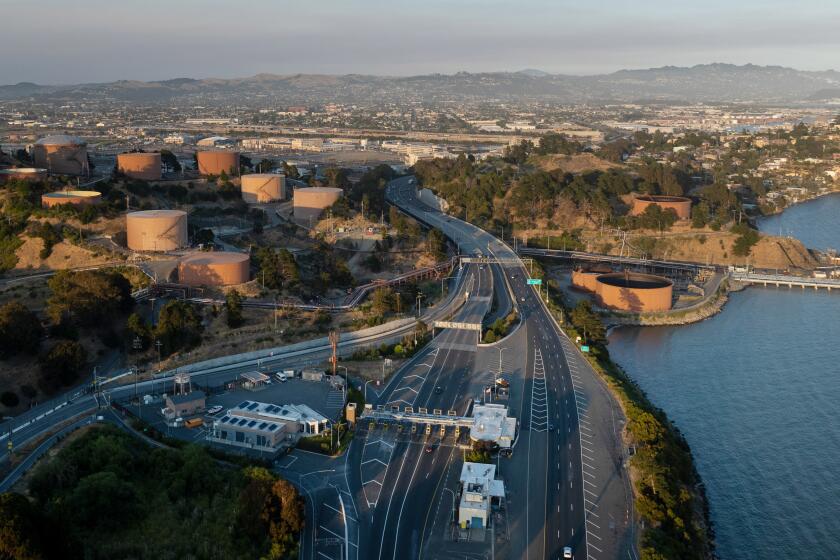L.A.’s Last Beef Plant Considers Packing It In
For Lloyd Manning, the owner of the last beef-packing plant in Los Angeles County, absolutely no part of a cow is sacred.
“If I could sell the moo, I’d do it,” said the tall, big-boned president of E.B. Manning & Son Inc., sitting in the office of his family’s custom meatpacking house in Pico Rivera.
Don’t think he hasn’t tried. A few years ago, he tape- recorded bawling Holstein steers as they entered his small corral and called Walt Disney Co. to see if the entertainment giant could use the real-live moos for the big screen. He was turned down.
But just about every other crazy scheme has worked. Manning found a market for the furrowed muscles of cows’ digestive tracts in Japan, where they are sliced, grilled and dipped in soy sauce. Cow tongues end up as taco filling in local Latino markets. Koreans and Mexicans mix neck bones and tails into soup. Eyeballs? Schools buy them so youthful scientists can practice their dissecting skills.
By exploiting the varied palates of the world’s consumers, and ferreting out customers for almost all of each bovine that arrives at his plant, Manning has stayed in business in the face of long odds. For 45 years, E.B. Manning & Son has survived a roller coaster of E. coli, “mad cow” and other food safety scares, as well as an industry consolidation that has left a handful of agricultural conglomerates dominating the cattle business from birth to slaughter.
Now, Manning reckons, he may have run out of creative options. Since the 1960s, more than 50 packers in the Los Angeles area have closed their doors, and he wonders whether it’s time to shut his.
“Go into the dope business,” joked the 55-year-old, fourth-generation meatpacker with a cowboy’s dark sense of humor. “It’s a lot more lucrative and you’ll have a lot more fun.”
Beef wasn’t as complicated when his great-grandfather Emerson B. Manning and grandfather Lew H. -- Big Louie, he was called -- came to California. Like many East Coast refugees who arrived in the late 1800s, they started working in the citrus groves. In the 1920s, they launched a side business in slaughtering cows. Three decades later, they opened a packinghouse east of Los Angeles surrounded by 160 acres of farmland.
Lloyd, one of three children born to Big Louie’s son Lloyd Sr., grew up with the smell of manure and blood. On weekends and during the summer, he cleaned the corral and the kill floor where the cows were slaughtered. By the time he went off to college, he vowed he would never work in the meatpacking business. After graduation he got a job as a commodities trader. But in 1985, when his family asked him to come home to help two years after his grandfather’s death, he returned to E.B. Manning & Son.
Those were tough times for the American cattle industry. In the mid-1970s, President Nixon had imposed price controls on beef and other staples to stem spiraling inflation. A drought had sent grain prices soaring, pushing up the cost of raising cattle. The expansion of supermarkets had closed many small neighborhood markets, putting more pricing power in the hands of fewer buyers.
Rise of Conglomerates
The biggest force for change, and consolidation, was the invention of labor-saving machinery that made it easier and cheaper to process huge numbers of cows. Today, four giant agricultural conglomerates slaughter more than 80% of U.S. cattle. They are Swift & Co., formerly ConAgra; Tyson Fresh Meats, formerly IBP; Excel Corp., a subsidiary of Cargill; and National Beef Packing Co.
To save the family business, Manning went looking overseas for connoisseurs of cow parts that would make some Americans queasy, and through the years he turned the plant into a model of precision slicing and niche marketing.
Meat cutters were taught how to slice off unwanted fat and bones and trim a carcass in the most profitable manner. They remove and clean the undigested matter inside the stomach so it can be sent to a composting company that blends it with grass clippings for fertilizer. Cows’ bottom teeth are sold to dental schools for students to practice drilling, and hair is used to make paintbrushes. Pet companies buy ears, hoofs and bull penises as ingredients in doggie chews.
And Manning cultivated a small following in the Jewish community. Three mornings a week, a trained kosher slaughterer, known as a shochet, goes to the plant. The shochet performs a blessing and then slaughters the cattle with a razor-sharp knife, killing them instantly. Before the carcasses are sent to the packing room, they are inspected to make sure that there are no lesions, particularly on the lungs, that would disqualify the meat from carrying the kosher label.
Finding just the right market is important: Selling a cow’s bones to South Korea -- instead of dispatching them to the rendering plant, where they would be turned into bone meal -- added 6% to 8% to the revenue that Manning could squeeze out of a carcass. (Privately held E.B. Manning does not disclose its finances.)
Where’s the Beef? Japan
For years, Manning’s most important market was Japan.
Beef had long played a secondary role there to seafood, pork and tofu. That began to change after World War II, when homesick Korean laborers in Japan began importing Korean barbecue with less-desirable meats like stomachs and tendons. Conventional beef cuts were scarce and expensive, because the government severely restricted imports to protect Japan’s small cattle industry.
Others followed suit, and the yakiniku craze was born. The Japanese could not get enough of grilled tongue or simmered small intestines, which was a boon for Manning and the entire U.S. beef industry. Imports of small intestines from the United States exploded after Osaka-based Stamina Foods created a packaged product called kottechan that people could cook at home. At one point in the 1990s, Japan was buying more than 80% of all cow tongues in the United States, bidding up the price a couple of dollars a pound, said Katsunori Hashimoto, an independent meat broker and consultant in Fullerton.
After Japan phased out its beef quota system in 1988 and replaced it with tariffs, Zenchiku Co., one of the leading meat companies there, decided to develop a U.S. supply base. Zenchiku purchased a cattle ranch in Montana and in 1990 bought E.B. Manning & Son. Lloyd Manning stayed on as president.
But as foreign beef flooded into Japan, prices plummeted. Manning and other small packers struggled to compete against the large American and Australian firms. In 1999, Zenchiku, now known as Starzen Foods, decided to cut its losses. It sold the business back to Manning for an undisclosed sum.
For Manning, it was time again to “shift 180 degrees.” He needed to find less-volatile markets closer to home, a search that became crucial in 2001, when the discovery of Japan’s first case of mad cow disease set off a panic. U.S. exports of beef to Japan plunged more than 50% in the last half of that year, the price of tongues was cut in half, and the dollar value of cattle dropped 1.5% in the United States, according to the U.S. Meat Export Federation.
Luckily, one foreign market had come to Manning.
During the 1990s, millions of people from Latin America had migrated to Southern California, bringing their meat-loving traditions with them. There were Latino butchers who wanted their beef carcasses “whole bone in,” which Manning’s plant was happy to provide, and Latino markets for such specialty products as cow heads, tails, tripe, livers, tongues and heart.
Meanwhile, to boost the confidence of the meat-wary, Manning developed a “natural beef product” from cows not injected with hormones or bulked up with chemical-laden feed. And the natural beef effort spawned another unexpected profit center: After hearing about it, Irvine-based Edwards Lifesciences, the pioneering developer of artificial heart valves, approached Manning about buying the pericardial sac that surrounds the cow’s heart. Now, he has a small room off the kill floor where the pericardial sacs are cleaned.
Tapping a Blood Line
Manning also sells blood and bile to pharmaceutical companies. The blood that doesn’t go there or to food companies, for use in blood sausages, is sent to a rendering plant along with the windpipe and some of the connective tissues. The cow’s “backstrap,” a tendon, is boiled down and turned into a gelatin for use in food products and candies.
Looking to the future, Manning is building a special sanitized facility for a process called “rinse and chill” in which the cow’s arteries are flushed out with a chilled water solution. That procedure, currently being used in Australia, is supposed to clean out bacteria and improve taste by preventing the blood from seeping into the meat.
Whether E.B. Manning & Son can profit from the procedure isn’t clear. Beef prices have risen sharply in recent months, in part because of a ban on cattle imports from Canada over a mad cow scare. But Manning has run out of cow parts to hawk, and his costs are climbing. Recently, he received a workers’ compensation insurance bill of nearly $800,000, triple what it was three years ago. He said his electrical bill has gone up 80% in the last two years.
Last year, Manning had a mild heart attack and bypass surgery. That caused him to reevaluate more than just his eating habits.
Pointing to a photo of his grandfather hanging on the wall above his desk, Manning said, “He died in 1983. My father died in 1991. I don’t want to be dead in 2004. I’d like to keep the tradition alive. It would be good for the industry, and it would be good for the consumer. But for peace of mind, it might be time to let go.”
More to Read
Inside the business of entertainment
The Wide Shot brings you news, analysis and insights on everything from streaming wars to production — and what it all means for the future.
You may occasionally receive promotional content from the Los Angeles Times.










